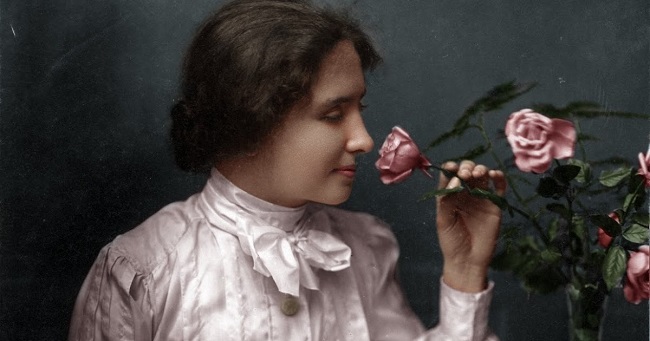In June 1946, a plane flew over the Mediterranean Sea from Rome to Paris. There was nothing unique about this flight other than the fact that one of the passengers took over as the pilot for the final 20 minutes of the trip. Dr. Helen Keller, an American novelist, educator, and campaigner who has been blind and deaf since childhood, was the passenger.
Keller had been in the air before, but many women of her generation would fly infrequently or never. On the set of Deliverance, a biographical movie about her life in which she truly appeared, she took her first trip as a passenger in 1919.

In Order To Dispel This Scepticism.
Even though Keller was well-known throughout the United States by the time she was 16 and abroad by the time she was 24, some members of the general public continued to have their doubts about Keller’s ability to successfully communicate with hearing people and earn a college degree, both of which she had already accomplished.
Deliverance’s creators stated that they intended to “show her doing all those things that [able-bodied] people do” in order to dispel this scepticism. This included “scenes in which she dresses herself, just to show the public that she can, and in which she sleeps, to prove to the curious that she closes her eyes.”
Additionally, because flying was so popular at the time and aeroplanes were still a relatively new invention, the creators chose to include Keller in the flying scene.
Read Also:
- Why Do I Cry When I Yawn
- What Does The Feeling Is Mutual Mean
- What Does It Mean When A Peacock Spreads His Feathers
Helen Keller: A Brief Overview
Before we delve into her aviation achievement, let’s briefly recap Helen Keller’s extraordinary life and the challenges she overcame:
- Early Life: Helen Keller was born on June 27, 1880, in Tuscumbia, Alabama, USA. At 19 months old, she fell ill with a fever that left her both deaf and blind.
- Anne Sullivan: Helen’s life changed dramatically when Anne Sullivan, a dedicated teacher, arrived to work with her. Through relentless determination, Anne taught Helen to communicate using the finger-spelling alphabet of the manual alphabet and braille.
- Education and Advocacy: Helen Keller went on to graduate from Radcliffe College with honors in 1904, becoming the first deafblind person to earn a bachelor’s degree. She became a renowned author and lecturer, advocating for the rights of people with disabilities and inspiring countless individuals around the world.
- Flying in the Face of Expectations: Despite her sensory limitations, Helen Keller’s indomitable spirit led her to pursue numerous adventures, including flying an airplane.
Flew The Four-Engine Aircraft Across The Mediterranean Sea
The article claims that Keller, who was born in Alabama, flew the four-engine aircraft across the Mediterranean Sea for 20 minutes. The Glasgow-based reporter was informed by Keller that she had flown the aircraft “via hand ‘speak'” between herself and Polly Thomson.
According to reports, Thomson stated, “She sat in the co-seat pilot’s with the pilot beside her, and I transmitted to her his directions.” “Her delicate touch on the controls astounded the flight crew. No trembling or vibration occurred. She simply sat there and controlled the plane firmly and calmly.
Keller was able to experience flying because of her enormous media success, both domestically and abroad. Few women of Keller’s generation would ever have taken a flight. Her first flight took place in 1919, when the biographical movie Deliverance about her aimed to show her engaging in “normal” activities (even though women almost never flew).
Prior to her journey in 1946, Keller took to the skies a few more times after developing a love for it. A plane, in her words, is “a giant graceful bird gliding across the illimitable skies,” she once remarked. It makes sense that she would later become a pilot.
She was given the controls of a Douglas Skymaster while she flew from Rome to Paris as part of a tour of Europe to advance the cause of blind people. Keller piloted the aircraft for 20 minutes over the Mediterranean Sea.
Helen Keller’s Flight in a Biplane
Helen Keller’s flight in a biplane was a momentous event in her life, reflecting her determination to experience the world in ways that defied societal expectations. Here’s how it all unfolded:
- Introduction to Aviation: In the early 1930s, aviation was gaining popularity, and flying was becoming more accessible. Helen Keller’s fascination with aviation grew as she learned about the achievements of aviators like Amelia Earhart.
- Connection with the Wright Brothers: Helen Keller’s strong interest in aviation led her to establish a connection with the Wright brothers, Orville and Wilbur, the pioneers of powered flight. Her correspondence with them was a testament to her curiosity and ambition.
- The Flight Experience: In 1933, at the age of 53, Helen Keller had the opportunity to experience flight firsthand. She embarked on a flight in an open-cockpit biplane, piloted by famed aviator Kenneth Jaynes. The flight took place in Los Angeles, California.
- Sensory Experience: Helen Keller, who was deafblind, experienced the flight through touch, vibration, and the sensation of wind on her face. Her heightened sense of touch allowed her to feel the vibrations of the engine and the movement of the aircraft.
- The Power of Touch: During the flight, Helen Keller’s fingers were placed on the pilot’s face and throat to allow her to feel the vibrations caused by the engine and airspeed. This tactile experience allowed her to “sense” the flight and appreciate the thrill of aviation.
- Emotional Impact: Helen Keller’s flight in the biplane was a deeply emotional and exhilarating experience for her. It symbolized her unwavering spirit and her belief that limitations could be transcended.
The Significance of Helen Keller’s Flight
Helen Keller’s flight in a biplane was more than just a daring adventure; it symbolized several important themes:
- Determination and Perseverance: Helen Keller’s life was a testament to her determination and perseverance. Her flight in a biplane underscored her belief that with determination, individuals can overcome seemingly insurmountable challenges.
- Breaking Barriers: As a deafblind individual, Helen Keller consistently shattered societal barriers and expectations. Her flight served as a powerful example of pushing the boundaries of what is possible, regardless of one’s disabilities.
- Inspiration to Others: Helen Keller’s achievements have long served as a source of inspiration for people with disabilities and beyond. Her flight inspired countless individuals to pursue their dreams and passions without limitations.
- Advocacy for Accessibility: Throughout her life, Helen Keller advocated for accessibility and equal opportunities for people with disabilities. Her flight highlighted the importance of making experiences, including aviation, accessible to all.
- Embracing Sensory Diversity: Helen Keller’s flight emphasized the richness and diversity of human sensory experiences. While she couldn’t hear or see, she could feel and sense the world in unique ways.
Read Also:
- Search For Whatever The Ship Was Carrying
- How To Get Rid Of Mold Spores In The Air
- Keisha Lance Bottoms Its Time To Pass The Baton
Final Words
Polly Thomson, her travelling companion, assisted her in following the pilot’s directions as they were communicated by hand “language.” The onboard staff was taken aback by her delicate touch on the controls.
There was no trembling or tremor, Thomson told the Glasgow Bulletin. She simply sat there and controlled the aircraft firmly and calmly. She said that it “was great to sense the delicate movement of the aeroplane through the controls,” Keller said.


